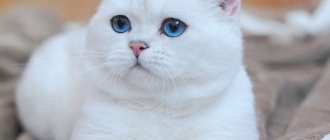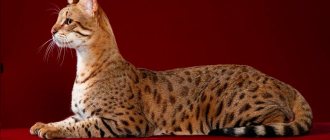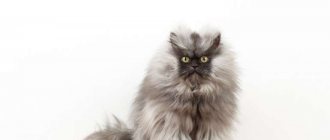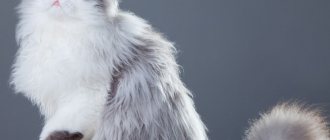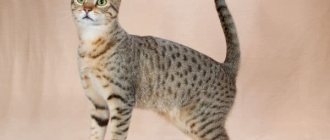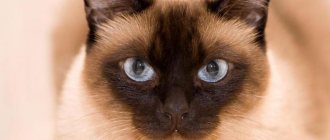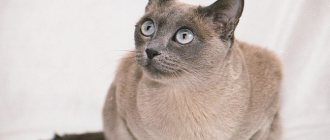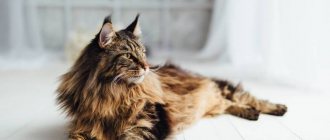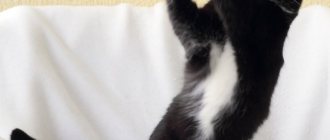“Moon Diamonds,” or Siamese cats, appeared in Europe at the end of the 19th century and since then have confidently held the palm among the most popular breeds. And this is no coincidence: Siamese are notable for their unusual color, expressive physique and interesting character. Therefore, breeders began to breed new breeds that are similar in appearance to the Siamese cat. However, they all have their own, unique features both in appearance and character.
Balinese
This cat breed got its name thanks to the plasticity and grace that cats have, named after the Balinese temple dancers.
This is a miniature, slender cat with unique grace. She is fluffier than the Siamese, she has an elongated body and long legs. The average cat weighs up to 4 kilograms.
Representatives of this breed are less aggressive than Siamese, friendly, sociable and very attached to their owner.
Difference in character
The breeds differ not only in appearance, but also in disposition. Siamese are more sociable and good-natured; they love the company of people and do not welcome loneliness. Siamese cats have a very shrill and loud voice; they love to complain to their owners and purr on their laps about their cat's lot. To these characteristics should be added the playfulness and very active lifestyle of the Siamese: the Siamese cat prefers to spend most of its time playing.
The Siamese's playfulness continues into old age.
Thai cats are calmer and are often described in one word – wise. They are calmer, no less friendly, and prefer to spend time alone next to their owner. They love to observe and create the world around them without unnecessary noise. They do not like to show aggression and get along well with other pets. Thais also do not like loneliness, but if the Siamese begin to loudly express their dissatisfaction, then the Thais become withdrawn and irritable.
Thais are calmer and often prefer peaceful sleep to noisy pastimes.
Burmese
Burmese cats were bred by French breeders in 1925. Outwardly, they resemble soft toys: fluffy with big blue eyes.
A distinctive feature of the Burmese are the “gloves” on their paws. She differs from the Siamese in her calm disposition, she can easily find something to do on her own, has a calm character and is moderately energetic. Representatives of this breed are good at feeling the mood of their owner: they can calm a choleric person or lift the mood of a melancholic person.
Health and life expectancy
The health of breeds varies. For example, Thais are susceptible to diseases of the genitourinary and musculoskeletal systems; they are characterized by joint dysplasia and arthritis. The life expectancy of Thais is 14-18 years, but there are cases where representatives of the breed lived up to 28 years.
It is recommended to monitor your pet's health with routine veterinary examinations.
Siamese live 13-20 years, sometimes more, with proper and complete care. There is a known case when a Siamese cat lived for 38 years. Representatives of the breed may suffer from diseases of the cardiovascular system and pathologies associated with protein metabolism in the body. Sometimes Siamese cats have congenital strabismus and, in general, the visual organs of this breed are a vulnerable spot.
Thai
Another close relative of the Siamese is the Thai cat. They originated from Thailand. Previously, the Thais guarded temples and lived at the court of the Siamese dynasty.
In their gracefulness they even surpass the Siamese. This breed has a playful disposition and is active until old age. They are very attached to their owners, which reminds them of a dog. These animals are not inherently timid; they are famous for their fearlessness.
Note: The Thai breed is suitable for lovers of temperamental and active animals.
He has a playful character and curiosity.
Beneath their fur they have a strong body with well-developed muscles, and they are slightly larger than their Siamese counterparts.
Standards for both breeds
Siamese and Thais are representatives of the Siamese-Oriental group and have a common ancestor - they are a mixture of two groups of cats with characteristic interspecific differences. Below we will take a closer look at the species differences between the Siamese and Thai cats:
- Siamese have an elongated, slender body, an elongated muzzle and a straight profile. Their paws are long, thin and graceful, with rounded pads. The ears are triangular, set wide apart, have sharp tips and appear disproportionate to the head. The tail is whip-shaped, long and pointed. The eyes are almond-shaped, slightly slanted. The fur is soft and often short, the undercoat is absent or weakly expressed.
The Siamese cat gave its color to many other cat breeds
- Thais have a more rounded and robust body structure, their limbs are more muscular and shorter. The muzzle has a rounded shape, the profile is rather convex rather than straight. The ears are small, with rounded tips, the tail is bushier and thicker, with a narrow tip. The coat is dense, rough to the touch, and there is no undercoat.
Selection has given the Thai breed not only beauty, but also an obedient disposition
Tonkinese
Tonkinese cats are the result of crossing the Siamese and the Sacred Birman. The breeders intended to get the strong physique of the Burmese cat and the color of the Siamese. But genetics has made its own adjustments to these tailed animals.
They have developed intuition, feel a person’s mood and know how to behave with him.
A distinctive feature is the aquamarine-colored eyes.
Note: it is believed that Tonkinese cats have strong energy fields, thereby being able to protect their owners and the house in which they live from negative influences.
Genetics issues
In genetics, everything is very strongly connected. Points in cats appear due to a special pigment - melanin, and this, in turn, due to the enzyme tyrosinase. The chain does not stop there either. At its base is the C gene. It is this gene that determines the final color of the hairs and iris.
The complete absence of pigment, characteristic of white coloring, occurs under the influence of the mutation gene c. Unlike its brother C, the c gene does not activate, but blocks the production of tyrosinase, which prevents color pigmentation and leads to the birth of an albino animal.
In addition to complete albinism, partial albinism is also possible. It is provided by the cs gene, which allows the pigment to penetrate into areas with the lowest temperature. This type of coloration is called acromelanism, or temperature-dependent.
“ INTERESTING!
The cs gene is recessive. It only works if both parents have it. The severity of the points is not important in this case. They may be hidden, but they still appear in at least some kittens.
Oriental
The Oriental breed was brought to Great Britain at the end of the 19th century. Since this breed was also brought from Thailand, they were initially classified as Siamese. But soon the British Siamese Cat Club set specific standards for this breed, and Orientals were not suitable for it because of its completely green eyes and solid gray color. But since 1925, the color of Orientals can be not only gray, as they began to be actively selected.
Representatives of this breed have active mobility and cheerfulness.
Note: Representatives of the Oriental breed are very attached to their owner and themselves and do not like to be alone.
Orientals have a strong build and thin bones. The tail is very long and thin.
Does color affect the character of a pet?
The main representatives of the Siamese color are firmly entrenched in the image of caricatured villains with a vengeful character. Irresponsible breeders, as well as the largest company, Disney, are partly to blame for this.
In the pursuit of profit, two things were ignored for a long time when breeding Siamese: squint and innate aggression. Both were not typical for these cats, so such animals had to be sterilized and neutered. In addition, mating with other breeds was actively practiced, and the behavior of mestizos is always unpredictable.
“ In 1955, 5 years before the Siamese standard was approved, Disney released the full-length cartoon Lady and the Tramp. The main villains there were Si and Ama - two Siamese cats. Thanks to the popularity of the cartoon, their image is firmly embedded in the minds of most viewers.
In fact, Siamese are one of the most loyal and very intelligent mustachioed pets. When properly bred and raised, they grow into docile and gentle companions.
Thanks to numerous experiments, points in kittens ceased to be a rarity and began to appear not only in Siamese, but also in many other purebred “mustaches.” Despite the change in coat color, the character of these animals remained the same.
" IMPORTANT!
Coloring is not able to influence the behavior of the animal. It only changes his appearance, and can also affect his health.
Himalayan
This breed was bred as a mixture of Persian and Siamese cats. For further breeding of the breed, only kittens with a pronounced Siamese color were selected. The Himalayan breed is less emotional than the Siamese and is more obedient. They have a strong build and therefore are not very mobile; they prefer calm play with their owner to jumping on curtains.
Note: The Himalayan breed is characterized by a sociable character and devotion to its owner.
Neva Masquerade
Comes from Siberian cats. Color-point Siberians have long been considered a waste. However, the breeders still decided to keep her. This is how a separate breed emerged. Independent, sometimes stubborn, but sociable and very active.
There are many breeds similar to the Siamese. All of them have their own characteristics. Therefore, everyone can find a pet in accordance with their character.
Funny and educational stories about your pets - subscribe to our channel!
Where are dogs' belly buttons? How to make friends between a cat and a dog? Why does a hedgehog laugh? The entire encyclopedia about animals is on our website.
Javanese
In the late 1970s, Maureen Davis began breeding Siamese-colored Balinese dogs, but in different colors. This is how the Javanese cat breed came about.
Javanese are very active and require a lot of attention, which they achieve by any means. They are distinguished by a strong attachment to their owners. The graceful, fragile appearance of these cats is surprisingly combined with their strength and strong muscles, which are hidden under a thin, silky coat. In everyday life they are hardy and unpretentious, they become very attached to children who know how to handle this independent creature. They mostly get along well with other pets; much in this situation depends on the character of their neighbor.
Point color varieties
The color-point group includes several varieties. To classify them, the color of the points is used, as well as the presence of patterns, white spots and other interesting features.
Solid or solid
Solids are characterized by uniform coloration of points. Depending on the color of the pigment, the following subspecies are distinguished:
- seal point (classic Siamese) – dark gray, close to black;
- red point – red (red);
- blue point – blue (gray);
- cream point – light red;
- chocolate point – brown;
- tortoiseshell tortoiseshell;
- lilac point – gray-pink;
- cinnamon point – cinnamon;
- fawn point – light beige.
The color of the points matches the paws and nose. Interspersed stripes, spots and other patterns in this group are unacceptable.
Links
They are characterized by the presence of a tabby pattern (spots, stripes or marbles) on the ears, face, paws and tail. On the forehead of an animal with a link point there is always a mark in the form of the letter “M”, or the sign of a scarab.
The color of the markings is always darker than the points. The names of the colors in this group are generated by adding the prefix “tabby-”: seal tabby point, red tabby point – and so on.
Color point with white
It is an unusual combination of points and piebald coloration. In most cases, white spots appear on the face and front legs. They also cover half or a third of the body, merging with each other into a giant spot indistinguishable to the eye.
Silver
Characterized by zonal coloration of hairs. The base remains completely white and the top is dark. The group includes 3 subspecies, differing in the amount of white:
- smoky – ½;
- shaded, or shaded – ⅓;
- chinchilla – ⅛.
Another variety is distinguished separately - the silver tabby. It is a simultaneous combination of tabby (pattern) and silver (zonal coloring with a beautiful sheen).
Seychelles
The homeland of these graceful animals is Great Britain. In the 70-80s of the last century, the British set out to breed a new breed of cats. With the blessing of the British Cat Association, breeders began work on crossing Siamese and Persian cats. The result is the appearance of Seychelles cats.
He has an aristocratic appearance, good manners and great demands. They will never allow themselves to be treated with disrespect. Seychelles cats differ from Siamese cats by having large ears of a non-standard shape. Like all representatives of oriental breeds, these cats create the impression of exaggerated elegance. In fact, they are quite strong and muscular.
Note: The Seychelles cat is a domestic breed; it is very difficult for her to tolerate travel and any change of environment.
What is the difference between Thai and Siamese kittens?
It is easier to distinguish a Thai kitten from a Siamese at the age of three months, when the characteristic features of the breed begin to appear in the baby’s appearance. During inspection, pay attention to the following features:
- Skull shape: Siamese have a more elongated and straight profile, while Thais have a more rounded skull shape;
- Ears: Siamese have them disproportionately large, while Thais have small and round ears;
- Body type: Siamese kittens have a longer body, Thai kittens have a more plump, rounded body;
- Eyes: Siamese have a more pronounced almond-shaped slanted eye shape, Thais have rounder and wider open eyes;
- Tail: The Siamese breed has a whip-like tail, while the Thai breed has a thick and bushy tail;
On the left is a Siamese kitten, on the right is a Thai kitten
Foreign White
Foreign White is a breed that is the result of the crossing of a Siamese and a solid white domestic cat. That is why these cats are also called white Siamese or white oriental shorthair.
The homeland of Foreign White is England. It was there that about 50 years ago, the famous geneticist Patricia Turner looked at an overexposed photograph of a lilac Siamese cat and came up with the idea to breed an all-white cat of the oriental type with blue eyes and without hereditary deafness.
In its temperament, this breed resembles a dog. Very active: they love to chase a ball, bring toys in their teeth, etc.
Note: Foreign White really does not like being alone, so if you are often not at home, make him a friend.
All of the above breeds are very similar to Siamese cats. And you will certainly be able to choose a suitable pet for yourself without any problems.
Color point color and its features
The English phrase color point is translated as “color spot”. With this color, most of the body remains almost white, and certain areas (legs, tail, ears and muzzle) are covered with dark spots.
“
REFERENCE!
The severity of the transition between light and dark zones determines the value of the animal. The larger it is, the higher the final cost. Residual patterns and spots on the body are considered defective.
The following features are characteristic of color-point colors:
- Temperature dependence. When it gets colder, the amount of dark shade increases.
- Age-related changes in the intensity of points. Newborn color point kittens are completely white or light cream. This is due to the consistently warm temperature in the mother's womb. The first black markings appear within a couple of days after birth, and by 6-10 months the coloring is completely formed.
- Relationship with the color of the iris. It can be strictly blue, and the clarity of the points depends on its brightness.
The darkening of the fur coat under the influence of cold is easy to notice in cold weather. If a cat sleeps on a windowsill, then the part of its body leaning against the window will lose its whiteness.
